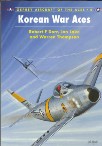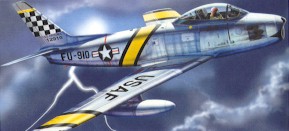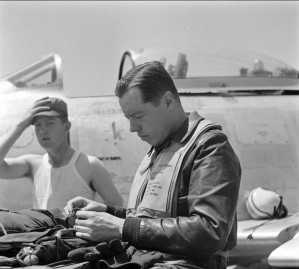Korean War Aces
USAF F-86 Sabre jet pilots
By Stephen Sherman, March, 2000. Updated April 20, 2012.
The pilots of the United States Air Force were heavily outnumbered and flew an airplane that in many ways was inferior to the MiG-15s flown by their Communist adversaries. Nor could they pursue the MiGs into their sanctuaries beyond the Yalu River. Nonetheless, they built up an impressive combat record.
They included old hands from World War Two like Gabby Gabreski, John Bolt, and Bud Mahurin; newcomers like Hal Fischer and Pete Fernandez; and future astronauts like John Glenn, Buzz Aldrin, and Wally Schirra. Forty American fighter pilots achieved the coveted status of "ace" in Korea. While USAF pilots dominated the ranks of 'aces', Navy and Marine aviators also carried out much of the unglamorous, but deadly bombing and ground-attack missions of the conflict.
Their stories follow.
First Battles
On June 25, 1950, the North Korean army rolled across the border and invaded South Korea. The air forces of the North included mostly Soviet propeller-driven aircraft like the Lavochkin La-7, Ilyushin Il-10 Sturmovik, and Yakovlev Yak-3, & Yak-7, & Yak-9, & Yak-18. Against them, the United States Air Force fielded F-80 Shooting Stars and F-82 Twin Mustangs, achieving good successes against the Communist airplanes. On the ground, the forces of the North rolled ahead, forcing the United Nations back to the "Pusan Perimeter" by late July. Despite these reverses on the ground, the UN air forces (augmented by carrier-borne US Navy and Marine fliers) controlled the skies over Korea, downing 20 North Korean prop-driven planes in the first month, but not scoring another air-to-air kill for over three months.
| Korean War Aces | |||||
|---|---|---|---|---|---|
| Name (USAF, unless noted) | USAF
Credits in Korean War |
WWII kills |
Unit | Plane | Adj. Claims per Soviet data |
| 16.0 | - | 51st FIW | F-86 | 13.0 | |
| 15.0 | 1.5 | 4th FIW | F-86 | 13.0 | |
| 14.5 | - | 4th FIW | F-86 | 13.5 | |
| 14.0 | 7.0 | 4th FIW | F-86 | 10.0 | |
| Col. Royal N. Baker | 13.0 | 3.5 | 4th FIW | F-86 | 11.0 |
| Lt. Col. Vermont Garrison | 10.0 | 7.3 | 4th FIW | F-86 | n.a. |
| 10.0 | - | 4th FIW | F-86 | n.a. | |
| 10.0 | - | 51st FIW | F-86 | n.a. | |
| Col. James K. Johnson | 10.0 | 1.0 | 4th FIW | F-86 | n.a. |
| Capt. Lonnie R. Moore | 10.0 | - | 4th FIW | F-86 | n.a. |
| Capt. Ralph S. Parr | 10.0 | - | 4th FIW | F-86 | n.a. |
| Capt. Cecil G. Foster | 9.0 | - | 51st FIW | F-86 | n.a. |
| 1st Lt. James F. Low | 9.0 | - | 4th FIW | F-86 | n.a. |
| Maj. James P. Hagerstrom | 8.5 | 6.0 | 67th FBS | F-86 | n.a. |
| 8.0 | - | 4th FIW | F-86 | n.a. | |
| Lt. Col. George I. Ruddell | 8.0 | - | 51st FIW | F-86 | n.a. |
| 1st Lt. Henry Buttelman | 7.0 | - | 51st FIW | F-86 | n.a. |
| Capt. Clifford D. Jolley | 7.0 | - | 4th FIW | F-86 | n.a. |
| Capt. Leonard W. Lilley | 7.0 | - | 4th FIW | F-86 | n.a. |
| 6.5 | 28.0 | 51st FIW | F-86 | n.a. | |
| Maj. Donald E. Adams | 6.5 | 4.0 | 51st FIW | F-86 | n.a. |
| Lt. Col. George L. Jones | 6.5 | - | 4th FIW | F-86 | n.a. |
| 6.5 | - | 4th FIW | F-86 | 5.0 | |
| (USMC) | 6.0 | 6.0 | 51st FIW | F-86 | n.a. |
| 6.0 | - | 4th FIW | F-86 | 5.0 | |
| Capt. Robert J. Love | 6.0 | - | 4th FIW | F-86 | n.a. |
| 5.5 | 15.5 | 51st FIW | F-86 | n.a. | |
| Col. Harrison R. Thyng | 5.0 | 5.0 | 4th FIW | F-86 | n.a. |
| Col. Robert P. Baldwin | 5.0 | - | 51st FIW | F-86 | n.a. |
| 5.0 | - | 4th FIW | F-86 | 5.0 | |
| Maj. Stephen L. Bettinger | 5.0 | - | 4th FIW | F-86 | n.a. |
| (USN) | 5.0 | - | VC-3 | F4U-5N | n.a. |
| Maj. Richard D. Creighton | 5.0 | - | 4th FIW | F-86 | 3.0 |
| Capt. Clyde A. Curtin | 5.0 | - | 4th FIW | F-86 | n.a. |
| Capt. Ralph D. "Hoot" Gibson | 5.0 | - | 4th FIW | F-86 | 2.0 |
| 5.0 | - | 51st FIW | F-86 | n.a. | |
| Capt. Robert T. Latshaw | 5.0 | - | 4th FIW | F-86 | n.a. |
| Capt. Robert H. Moore | 5.0 | - | 51st FIW | F-86 | n.a. |
| Capt. Dolphin D. Overton | 5.0 | - | 51st FIW | F-86 | n.a. |
| Maj. William Westcott | 5.0 | - | 51st FIW | F-86 | n.a. |
| All aces with 5+ claims listed above; other notable Korean War fighter pilots below. | |||||
| Maj. Felix Asla | 4.0 | - | 4th FIW | F-86 | n.a. |
| 4.0 | 11.0 | 51st FIW | F-86 | n.a. | |
| 3.5 | 20.5 | 51st FIW | F-86 | n.a. | |
| Lt. Col. Edwin E. Heller | 3.5 | 5.5 | 51st FIW | F-86 | n.a. |
| (USMC) | 3.0 | - | 51st FIW | F-86 | n.a. |
| 2.0 | 18.5 | 4th FIW | F-86 | n.a. | |
| Capt. Philip DeLong (USMC) | 2.0 | 11.0 | VMA-312 | F4U-4 | n.a. |
| 1st Lt. Edwin E. "Buzz" Aldrin | 2.0 | - | 51st FIW | F-86 | n.a. |
| 1.0 | - | - | F-80 | n.a. | |
| - | - | - | F-86 | n.a. | |
| Russian Aces of the Korean War | |||||
| 19.0 |
-
|
196 IAP |
MiG 15 |
n.a. |
|
In early November, 1950 Soviet MiG-15s first ventured across the Yalu to engage the USAF, and on the 26th, half a million Chinese infantry attacked across the whole front, sweeping back MacArthur's troops. In the air, the MiG-15s similarly swept aside the out-classed American F-80s and assorted prop planes. In December, the USAF brought the 4th Fighter Interceptor Wing (4th FIW), equipped with North American F-86 Sabre jets into the conflict. The Sabre was a match for the MiG. On December 17, F-86s of the 336th FIS (Fighter Interceptor Squadron), 4th FIW ran their first fighter sweep along the Yalu, the area known as "MiG Alley." The Sabres engaged the MiG-15s on roughly equal terms, and soon scored aerial victories against the Russian jets.
In December, 1950, US naval aviator Thomas Hudner earned the Medal of Honor for his valiant efforts to rescue his downed comrade, Jesse Brown (the US Navy's first African-American aviator).
MiG 15 versus F-86 Sabre
The MiG could fly higher, 50,000 vs. 42,000 feet, offering a distinct advantage at the start of combat. In level flight, their maximum speeds were comparable - about 660 MPH.. The MiG could climb better, the Sabre was more maneuverable and could dive better. For weapons, it carried two 23mm and one 37mm cannon, compared to the Sabre's six .50 caliber machine guns. The American weapons, while not packing as much of a punch, carried many more rounds and were aimed with a superior gunsight. Maintenance of the Sabre was a headache and a large fraction of the UN air strength was "in the shop" at any time.
By early 1951, the battle lines hardened and didn't change too much for the rest of the conflict. In April, MacArthur was sacked. Throughout the summer and early fall of 1951, the outnumbered Sabres (44 at one point) of the 4th FIW continued to seek battle with the 500+ MiGs near the Yalu. Jabara, Becker, and Gibson became the first Sabre aces. Following Col. Thyng's famous message to the Pentagon, the 51st FIW reinforced the beleaguered 4th in December 1951. For the next year and a half, the dual continued, in generally the same fashion. New, improved models of the F-86 appeared: the 'E' in early 1952 and the 'F', with its hard wing, in August. These later Sabres gave the UN pilots an increasing edge over the Communist MiG-15s.
Major George Davis, the leading MiG-killer at the time with 14 claims, was lost in action in February, 1952, on a mission that won him the Congressional Medal of Honor, the only Sabre pilot to earn the nation's highest military decoration. In April, Iven (sic) Kincheloe became the 10th ace and in September Robbie Risner became the 20th. During 1952, some pilots were flying unauthorized 'Maple Special' missions, designed to lure MiGs into dogfights and then pursue them across the Yalu, where some were shot down.
In March of 1953, Major George Jones became the 30th American ace of the Korean war. By this time peace talks were starting, and when Ed Heller was shot down on the wrong side of the Yalu it created quite a furor. Heller, along with Fischer, Mahurin. and Bettinger became a POW; three other Korean aces (Risner, Low, & Kasler) later became POWs in Vietnam. In July, 1953, just days before the armistice, Guy Bordelon, flying a F4U-5N, became the 40th and final Korean ace. He was the only US Navy ace and the only propeller ace.
Claims
The numbers shown above, and used throughout, are claims, and are almost certainly in excess of the actual number of MiGs downed. During the war the USAF pilots claimed over 800 enemy planes. Postwar research revised that figure downward to 379, which closely matches the admitted Russian losses of 345. The Air Force has not disclosed, perhaps does not fully know, which pilot claims to revise, so the contemporary numbers stand, although, as in all claims for aerial victories, the claims exceed the other side's documented losses.Adjusted Claims per Soviet Data
In the years since the breakup of the old Soviet Union, records relating to the Korean War have come to light. Aviation history researchers like Cookie Sewall and Diego Zampini have pored over these records and have been able to correlate Soviet records of specific aerial battles on specific dates, and thus documented certain over-claims by the USAF pilots. As noted above, over-claims have occurred in all wars and amongst all combatant nations. John Lundstrom similarly researched American overclaims versus Japanese air forces in WW2.
The adjusted claims shown here in no way detract from the heroic accomplishments of the aces. In any historical research, accuracy is all-important; without striving for accuracy (within the limits of resources, documents, archaeological evidence, etc.) it is not history, it is merely story-telling.
The "Adjusted Claims" column represents a work in progress. As
no Chinese archives have been opened up at this time, only USAF claims
against Russian air forces have been reviewed. (In other words, the
claims against Chinese air forces are counted here, without any
challenge.) I hope to provide more documentation, identifying the dates
and circumstances of the reduced claims. The "n.a" simply means that I
have no information about any adjustments for that pilot; the USAF
number should stand.
Sources, Links, and Recommended Books:
- F-86 Sabre - Korean War Jet Fighter
- Naval Aviation Involvement - Korean War - more info about naval aviation in the Korean War than you can imagine, the original Action Reports of the Carriers and Air Groups, as well as contempory issues of Naval Aviation News. These are slow-loading .pdf files, but they are great. This is the kind of original source material that I would like to see more of on the net.
 Robert
F. Dorr, Korean
War Aces, Osprey Aircraft of the Aces, 1995
Robert
F. Dorr, Korean
War Aces, Osprey Aircraft of the Aces, 1995
-
 James
Salter, The
Hunters, Vintage Books, 1999 re-issue
James
Salter, The
Hunters, Vintage Books, 1999 re-issue
- written by USAF Korean War fighter pilot, James Horowitz, pen name James Salter
- more introspective, and less "shoot-em-up" than many war novels
- made into a movie starring Robert Wagner as a character based on Lt. James Low, nine-kill ace -
 James A. Michener, The
Bridges at Toko-Ri, Crest Books, 1989 re-issue
James A. Michener, The
Bridges at Toko-Ri, Crest Books, 1989 re-issue
"Where did we get such men?"




